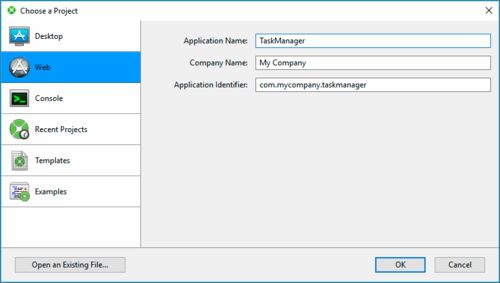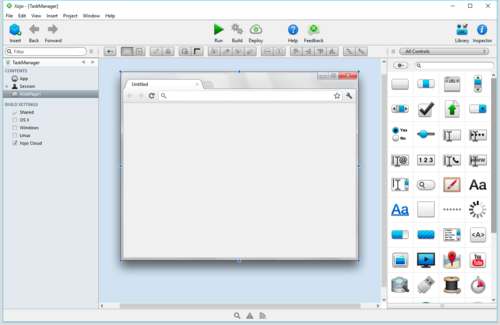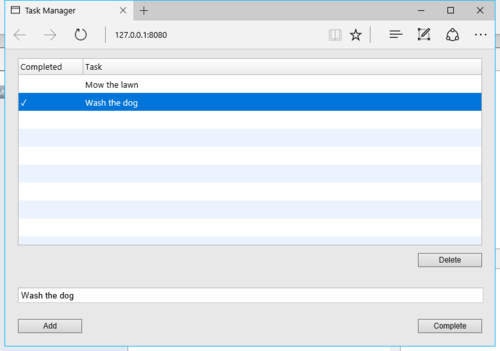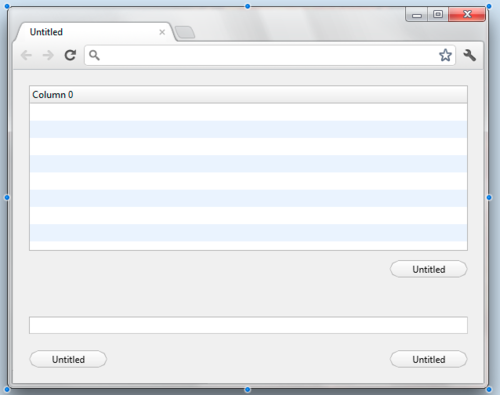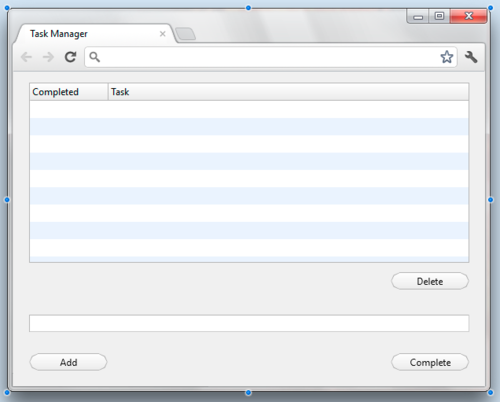Web Tutorial
From Xojo Documentation
This Web Tutorial is for people who are new to programming and new to Xojo. It is an introduction to the Xojo development environment and will lead you through the development of a real web app.
It should take you about an hour to complete this tutorial. If you would like a shorter introduction to Xojo for web, take a look at the Web QuickStart.
If you have experience with other programming languages, you’ll also want to check out the User Guide and Reference Guide.
Contents
Getting Started
If you haven’t done so already, now is the time to start Xojo. After it finishes loading, the Project Chooser window appears.
Xojo lets you build several different types of apps (Desktop, Web, Console and iOS). For this Tutorial, you are building a web app, so click on Web.
You should now see three fields that need values: Application Name, Company Name and Application Identifier.
- Application Name is the name of your app. This will be the filename of the actual app file that gets created.
- Company Name is the name of your company. You may choose to leave this blank.
- Application Identifier is a unique identifier for this app. It will automatically populate using what you enter for the Application and Company Names, but you can also change it to whatever you want.
Enter "TaskManager" as the Application Name. You can leave Company Name as it is or change it. Click OK to open the main Xojo window (called the Workspace), where you will begin designing your app.
Workspace
Xojo opens the Workspace with the default web page for your app selected in the Navigator and displayed in the Layout Editor.
Navigator: The area on the top left shows you all the items in your project. By default you can see WebPage1 (which is selected), the App object and the Session object. You use the Navigator to navigate within your project.
Layout Editor: The center area is the Layout Editor. You use the Layout Editor to design the user interface for the web pages in your app. It shows the web page and previews how it looks when the app runs in a web browser. In this image, the web page is blank because you haven't yet added any user interface controls from the Library.
Library: The area on the right is the Library and shows the controls and interface elements that you can add to a web page or to the project. You design the web page by dragging controls from the Library to the web page. You can also add a control to the web page by double-clicking it. You can change how the controls display in the Library by clicking the small gear icon and choosing a different setting.
If the Library is not visible, click the Library button on the toolbar to show it.
Inspector: Not shown in the above image is the Inspector, which allows you to see and change the properties for the selected control. This area of the Workspace window is shared with the Library. You can show the Inspector by clicking the Inspector button on the toolbar. The Inspector shows information about the selected item in the Navigator or Editor. The contents of the Inspector changes as you click on different items. You change an Inspector value by entering a new value in the field to the right of the field label.
About the App
In this tutorial you will create an app to track tasks.
Task Manager
For the Task manager app, you enter tasks in the text field and click Add to add them to the list. You can click on individual tasks in the list to delete them or mark them as complete.
Task Manager uses three controls:
- WebTextField: A WebTextField control is used to enter text. In this project, the task to add is entered into a WebTextField at the bottom of the window.
- WebButton: A WebButton is used to trigger an action. This project uses several buttons to perform different actions.
- WebListBox: A WebListBox is used to display a list of data. In this project, it is what displays the tasks entered in the TextField.
The next sections walk you through creating the user interface and adding the necessary code to make the app work.
Designing the User Interface
Task List
You should have Xojo running and WebPage1 open in the Layout Editor. You are now going to add a Listbox to the web page. The Listbox is used for storing the tasks.
- Add the Listbox: In the Control Library, click on the Listbox and drag it to the top-left corner of the Layout Editor. As you get close to the edges of the web page, you will see alignment indicators that help you position the control. Drop the Listbox when you are happy with its position on the web page.
- Resize the Listbox: Click on the Listbox so that the resizing handles appear. Grab the handle in the bottom-right corner and drag it to enlarge the Listbox to fill the top 2/3 of the web page.
Buttons
Now you will add the three buttons needed by Task Manager to the web page.
The Delete button removes tasks from the Listbox, the Add button adds tasks to the Listbox and the Complete button marks tasks in the Listbox as completed.
- Add the Delete Button: In the Library, click on the Button control and drag it to the web page below the lower-right corner of the Listbox. Use the alignment indicators to help you position the button so that it lines up with the right edge of the Listbox
- Add the Add Button: In the Library, click on the Button control and drag it to the web page near the bottom-left corner. Again, take advantage of the alignment indicators to help you position the button.
- Add the Complete Button: In the Library, click on the Button control and drag it to the web page near the bottom-right corner.
Text Field
The Text Field is where the user types the Task to add to the list.
- In the Library, click on TextField and drag it to the web page so that it is between the delete and add buttons.
- Resize the Task field. Select the rightmost drag handle and drag the TextField so that it is the same width as the Listbox. Use the alignment indicators as guides to help you line everything up correctly.
After adding all the controls, your web page should now look like this:
Properties
What is a Property?
A property is a value of a class. Changing property values allows you to change the behavior of the object. For this project, you want to change various properties for the view and the controls you added. Some of the things you need to do are:
- Rename all controls (and the web page) so that they describe their behavior and are easy to refer to in code.
- Add a Caption to the Button.
- Set Locking properties so that the controls resize properly when the window is resized.
Inspector
The Inspector is used to change view and control properties. It shares the same area on the right of the Workspace as the Library. In order to show the Inspector, click the Inspector button on the toolbar or press ⌘-I (Ctrl+I on Windows and Linux).
Web Page Properties
If you haven’t already, display the Inspector by clicking the Inspector button on the toolbar. You need to change the Name and Title properties of the web page:
- First, in the Layout Editor, click on the title bar of the web page to select it. The Inspector pane now shows the properties for the web page.
- In the Name field (located in the ID group), change the name from “WebPage1” to “TaskManagerPage”. Press Return to see the name change in the Navigator.
- In the Title field (located in the Frame group), change the name from “Untitled” to “Task Manager”. Press Return to see the name change in the title bar of the web page.
ListBox Properties
The Listbox is where the tasks that your user enters are displayed and stored. You need to change the following properties: Name, ColumnCount, Default Value, ColumnWidths and Locking.
- First, in the Layout Editor, click on the Listbox to select it. The Inspector pane now shows the properties for Listbox.
- In the Name field (located in the ID group), change the name from “Listbox1” to “TaskList”. Press Return to see the name change in the Navigator.
- The Listbox has two columns, one to show the completed status and another to show the name of the task. In the ColumnCount field, change the value from “1” to “2”. Press Return to see the Listbox appear with two columns on the web page layout.
- You want to change the column headers to describe the data in the list. Click the “Set Default Value of TaskList...” button on the Layout Editor toolbar. This opens the Value Editor popout window:
- Click on “Column 0” in the header to select it and then click on it again to edit its value. Type “Completed” and press Return.
- Click on “Column 1” in the header to edit its value. Type “Task” and press Return.
- Click on the “Set Default Value of TaskList...” button again to close the popout window. “Completed” and “Task” now appears as the headers for TaskList.
- Since Completed is only going to contain a simple checkmark when the task is marked as completed, it can be narrower. In the ColumnWidths field, change the value from “*” to “100,*”. Press Return to see the column widths change on the web page. Using “100,*” tells the Listbox that the first column should always be 100 pixels wide and that the rest of the columns share the available width.
- Lastly you need to make changes to the locking so that the Listbox gets larger or smaller as the web page size changes. In the Locking group look at the image that shows the web page with small locked icons for the top and left and small unlocked icons for bottom and right. Click the locks so that top, left, bottom and right are all locked.
Button Properties
The three buttons are used to perform actions. You need to change the following properties for each button: Name, Caption and Locking.
Delete Button
The Delete button is used to remove tasks from the TaskList.
- First, in the Layout Editor, click on the Delete button to select it (this is the button directly below the Listbox). The Inspector now shows the properties for WebButton.
- In the Name field (located in the ID group), change the name from “Button1” to “DeleteButton”. Press Return to see the name change in the Navigator.
- In the Caption field (located in the Appearance group), change the name from “Untitled” to “Delete”. Press Return to see the name change on the button in the web page.
- Now you need to make changes to the locking so that the Delete button stays on the right side of the web page when the web page resizes. In the Locking group look at the image that shows the web page with small locked icons for the top and left and small unlocked icons for bottom and right. Click the locks so that right and bottom are locked and left and top are unlocked.
Add Button
The Add button is used to add the task entered in the TextField to the Task List.
- In the Layout Editor, click on the Add button to select it (this is the button on the far left of the web page below the TextField). The Inspector now shows the properties for PushButton.
- In the Name field (located in the ID group), change the name from “Button2” to “AddButton”. Press Return to see the name change in the Navigator.
- In the Caption field (located in the Appearance group), change the name from “Untitled” to “Add”. Press Return to see the name change on the button in the web page.
- Now you need to check the locking so that the Add button stays on the bottom of the web page when the web page resizes. In the Locking group look at the image that shows the web page with small locked icons for the top and left and small unlocked icons for bottom and right. Click the locks so that left and bottom are locked and top and right are unlocked.
Complete Button
The Complete button is used to mark a task as completed.
- In the Layout Editor, click on the Complete button to select it (this is the button directly below the TextField on the right). The Inspector now shows the properties for WebButton.
- In the Name field (located in the ID group), change the name from “Button3” to “CompleteButton”. Press Return to see the name change in the Navigator.
- In the Caption field (located in the Appearance group), change the name from “Untitled” to “Complete”. Press Return to see the name change on the button in the web page.
- Now you need to make changes to the locking so that the Complete button stays on the right side of the web page when the web page resizes. In the Locking group look at the image that shows the web page with small locked icons for the top and left and small unlocked icons for bottom and right. Click the locks so that right and bottom are locked and left and top are unlocked.
- In the Project List, the newly renamed controls show under the Controls for TaskManagerPage.
Text Field Properties
The TextField is where your user will type the task to add to the list. You need to change the following properties: Name and Locking.
- In the Layout Editor, click on the WebTextField to select it. The Inspector now shows the properties for WebTextField.
- In the Name field (located in the ID group), change the name from “TextField1” to “TaskField”. Press Return to see the name change in the Navigator.
- Now you need to make changes to the locking so that the TextField gets larger or smaller when the web page resizes. In the Locking group look at the image that shows the web page with small locked icons for the top and left and small unlocked icons for bottom and right. Click the locks so that left, bottom and right are locked and top is unlocked.
Final Layout
After adjusting all the properties for the web page and its controls, your layout should look like this:
Running the App
Your user interface layout is now complete, so it’s time to try it out. But before you go further, you should first save your work.
Save the project by choosing File ↠ Save.
- Name the project “TutorialWeb” and click Save.
Now you can test your app:
- Click the Run button in the toolbar to run the project.
- When Task Manager is displayed, you can interact with the buttons by clicking on them, you can type in the TextField and you can resize the web page to see the buttons reposition themselves.
- Close the browser tab or window to return to the Layout Editor.
Of course, Task Manager doesn’t do anything yet! For that you need to add some code, which is what you'll do next.
Adding Code
Add Button
The Add button adds tasks to the list. The code you add to the button needs to take what was typed in TaskField and add it as a new row to the list. Follow these steps to add the code:
- On the web page, double-click the AddButton control, labelled “Add”. The Add Event Handler window appears. When a user clicks on a WebButton, the Action event handler is called. This means you want to add your code to the Action event handler, so select Action from the Event Handler list and click OK. This displays the Code Editor. Also notice the Navigator updates to show the Action event underneath the AddButton control.
- Now you need to get the task that was typed into the Task field. You might think you could get the task just by referring to the name of the field, TaskField. That is close, but not quite what you want. What you instead need is a property of TaskField. When you need to refer to a property of an object, you use the name of the object, followed by a dot, followed by the name of the property. In other words, you use this syntax: ObjectName.PropertyName. This is something called “dot” notation and is commonly used in object-oriented programming. In this case the object is TaskField and the property you want is Text (use the Language Reference to find out about all the properties available to TextFields). The syntax looks like this: TaskField.Text
- To actually add a row to a Listbox, you use the AddRow method. You already know how to get the text in the Task field from step 2. As you have seen before, objects can have properties. And as you now see with TaskList, objects can also have methods. AddRow is one of many methods available to Listboxes and it adds values to the two columns in TaskList. The first column contains the completed status, so it is initially set to blank. The second column contains the name of the task. Here is the code: TaskList.AddRow("", TaskField.Text)
- Save the project by choosing File ↠ Save.
- Run the app to test it out. Type tasks in the task field and click the Add button to see them appear in the task list. Close the browser tab or window to return to the Code Editor.
Complete Button
When the user clicks the Complete button, the selected task in the Listbox should be marked as completed. This is indicated by showing a checkmark (✓) in the Completed column.
Follow these steps to add the code:
- On the web page, double-click the CompleteButton control, labelled “Complete”. The Add Event Handler window appears. When a user clicks on a WebButton, its Action event handler is called. This means you want to add your code to the Action event handler, so select Action from the Event Handler list and click OK. Notice the Navigator updates to show the Action event underneath the CompleteButton control and the code editor displays.
- To change a row, you first need to know what row is selected. In a Listbox, the currently selected row is contained in the ListIndex property.
- To set the value in a particular cell of a Listbox, you use the Cell property, specifying the row and column. This code put the checkmark character in column 0 (the completed column) of the currently selected row: TaskList.Cell(TaskList.ListIndex, 0) = "✓"
- Run the app and add a few sample tasks. Now click on a task and click the Complete button. A checkmark appears in the Completed column. Close the browser tab or window to return to the Code Editor.
Delete Button
The Delete button is used to remove tasks from the list. The code you add to the button needs to determine the selected row in the list and remove it from the list.
Follow these steps to add the code:
- On the web page, double-click the DeleteButton control, labelled “Delete”. The Add Event Handler window appears. As you learned with the other buttons, you want to use the Action event handler to have your code run when the user clicks on a button. Select Action from the Event Handler list and click OK. Notice the Navigator updates to show the Action event underneath the DeleteButton control and the code editor displays.
- Since the selected row will be deleted, you again want to use the ListIndex property.
- Use the Listbox method RemoveRow to remove a row from the Listbox. You pass RemoveRow the row number to remove as a parameter. So your code looks like this: TaskList.RemoveRow(TaskList.ListIndex)
- Save the project by choosing File ↠ Save.
- Run the app and add a few sample tasks. Now click on a task in the Task List and click the Delete button. The task is removed from the list.
Debugging
Finding Bugs is part of creating apps. A bug is when your code or app does something unexpected, often leading to a crash. Although your app works just fine, there are a couple of lingering bugs that need addressing. Have you figured out what the problem is?
Here’s a hint: What happens if you you click on the Complete or Delete buttons but have not selected a task? Try it.
- Run the app and click on the Complete button without doing anything else. Your app will switch to the Debugger with a line of code highlighted. Your code generated an OutOfBoundsException and you are now in the debugger. The error occurred because you attempted to remove (or complete) a row that does not exist. When no row is selected in the Listbox, the ListIndex property returns -1. Since this is not a valid row in the Listbox, the Cell method raises an OutOfBoundsException.
- Click the Resume button in the debugger toolbar, to see the actual error message.
- Close the browser tab or window to return to the Editor.
Nobody wants buggy code. Luckily it is easy to prevent this bug from occurring. Essentially, you want to make sure a row is selected before you attempt to Delete or Complete a task.
- The code to do this uses what you have already learned. This is the code for Action event handler of the DeleteButton:
- The code for the Complete button is similar:
- In both cases, the code verifies that a row is selected by checking the ListIndex property to ensure that it contains a valid row before the actual method is called.
- Save the project by choosing File ↠ Save.
- Run the project again and click the Complete button without selecting a row in the task list. No more crash!
Finishing the App
Testing
Just because your app seems to work, doesn’t mean you are finished with it. A good developer always thoroughly tests their apps to look for possible problems.
You already found and fixed one problem (clicking Delete when no row was selected). Do you think there are other problems to fix? Run the app and play around with it a bit. Make a note of things you want to change. In the next section, you will add some improvements to Task Manager.
Improvements
Did you notice that there are times when the buttons in Task Manager probably should not do their action? For example, the Complete button should not try to mark a task as completed if one is not selected. Right now you can click it, but nothing happens. Also, you are not going to want to add a task to the list if nothing has been entered in the task field.
There are several ways to accomplish this, but one way is to disable the buttons when they should not be used.
Follow these steps to add this improvement:
- On the web page, select CompleteButton, labeled “Complete”. In the Inspector, turn the Enabled property (in the Appearance group) to Off.
- Select AddButton, labeled “Add”. In the Inspector, turn the Enabled property (in the Appearance group) to Off.
- Select DeleteButton, labeled “Delete”. In the Inspector, turn the Enabled property (in the Appearance group) to Off.
- Now you will add code to enable the Add button when there is text in the Task Field. On the web page, double-click the TaskField control. The Add Event Handler window appears. Here you are seeing yet another list of event handlers. Every control type has its own specific list of event handlers. In this case, we want to disable AddButton when there is no text in the task field and enable it when there is text. The TextChanged event is called whenever the text in the task field is changed, either by the user typing or by your code changing the Text property. Select TextChanged from the Event Handler list and click OK. Notice the Navigator on the left updates to show the TextChanged event underneath the TaskField control and the code editor displays.
- You now need code that checks the Text property of the TextField (Me.Text) to see if anything is there. If there is text there, then the AddButton is enabled by setting its Enabled property to True. If there is no text, then it is disabled by setting its Enabled property to False. This is the code:
- You already added code to prevent the Delete and Complete buttons from doing anything if no row is selected in the Task List. Now you can also make those buttons enable when a row is selected and disable when no rows are selected. This is accomplished with the ListIndex property of the Listbox.
- Double-click the TaskList control. The Add Event Handler window appears. Here you are seeing the list of event handlers for WebListBox. The SelectionChanged event is called whenever the selection in the TaskList control changes. Select SelectionChanged from the Event Handler list and click OK.
- Add this code:
- Save the project by choosing File ↠ Save.
- Run the app to test it out. Notice that the Add button is initially disabled. But try typing some text in the Task field. The Add button immediately become enabled. And if you remove the text from the Task field, the buttons again become disabled. Similarly, when you click on a row in the Task List, the Delete and Complete buttons become enabled.
Deploying the App
There are several ways to deploy a Xojo web app. The easiest way is to use Xojo Cloud so that you can just click "Deploy" on the main toolbar to send your app to web server where it can be used.
You can also deploy apps yourself in two ways. You can create a "standalone application" that is a self-contained app and web server. You can run this app on any computer or server. Users can access the app by using the computer's URL and port number. Alternatively, you can create a CGI app that is deployed alongside a full-features web server (such as Apache).
To learn more about these options, refer to Web App Deployment Overview in the User Guide.
Next Steps
Congratulations, you have successfully completed the Web Tutorial and now have a fully functional app. To continue on your journey of learning Xojo, you should next move on to the User Guide, which covers Xojo in its entirety. You will also want to refer to the Reference Guide, which covers the specifics of language elements, classes and other details of Xojo.

